what techniques do we use to study the interior of the earth
How do nosotros really know what'south inside the Earth? Imaging Globe's interior with seismic waves
Intermediate

- Instructor Guide & Student Worksheets
- Republic of haiti Tape Section
- Earth Scale Model
- Blank Graph
- Slide deck
Download All 9MB
Students will exist able to:
- Describe Earth's internal structure (layers of different cloth backdrop and composition) and summarize how this is inferred through the assay of seismic data
- Estimate the size of Earth's core using a record section from a recent earthquake
- Describe how main and secondary waves propagate through Earth
Differentiate between Earth'southward asthenosphere and lithosphere (layers of different mechanical properties)
Objectives:
Students will be able to:
- Draw Earth'southward internal structure (layers of different material backdrop and composition) and summarize how this is inferred through the analysis of seismic data
- Estimate the size of Earth'southward core using a record section from a recent earthquake
- Describe how master and secondary waves propagate through Globe
- Differentiate between Earth'due south asthenosphere and lithosphere (layers of dissimilar mechanical properties)
Related Lessons
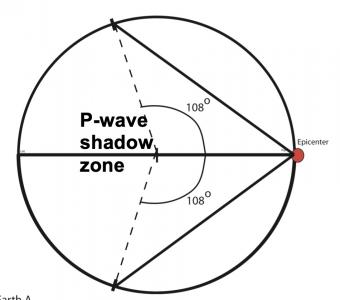
Students work first in small groups, and then equally a whole class to compare predicted seismic wave travel times, generated by students from a scaled Earth model, to observed seismic data from a recent earthquakes. This activity uses models, real data and emphasizes the process of science.
Lesson Novice
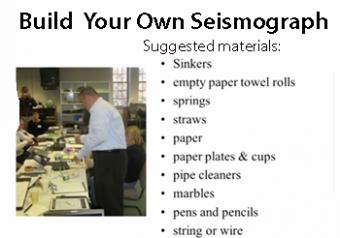
Working in small-scale groups of 3-iv, students design and construct a seismograph using common household and craft materials provided. Students volition demonstrate to the class (past shaking their table) how their seismographs records ground motion and if possible, the fourth dimension of the disturbance occured.
Lesson Novice
Related Fact-Sheets
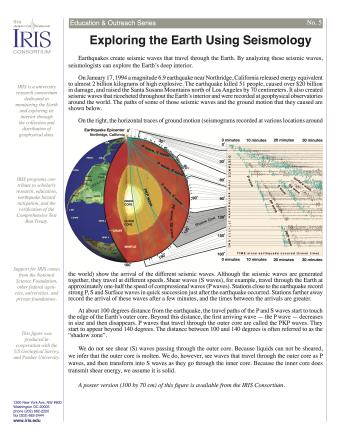
Earthquakes create seismic waves that travel through the World. By analyzing these seismic waves, seismologists can explore the Globe's deep interior. This fact sheet uses information from the 1994 magnitude vi.9 earthquake near Northridge, California to illustrate both this process and Earth'south interior structure.
NOTE: Out of Stock; cocky-printing only.
Fact-Sheet Novice
Related Animations
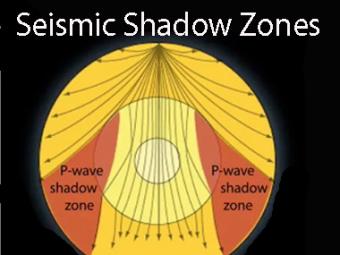
Seismic shadow zones take taught us much about the inside of the earth. This shows how P waves travel through solids and liquids, but Due south waves are stopped by the liquid outer cadre.
Blitheness Novice
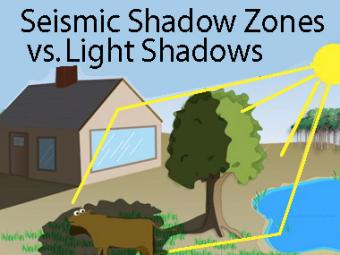
The wave backdrop of light are used equally an analogy to help us sympathize seismic-moving ridge behavior.
Animation Novice
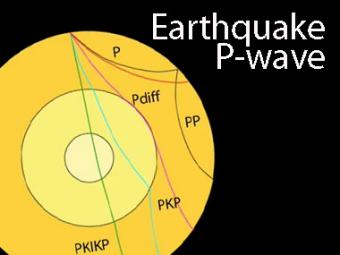
The shadow zone is the area of the earth from angular distances of 104 to 140 degrees from a given earthquake that does not receive any direct P waves. The unlike phases bear witness how the initial P wave changes when encountering boundaries in the Earth.
Blitheness Novice
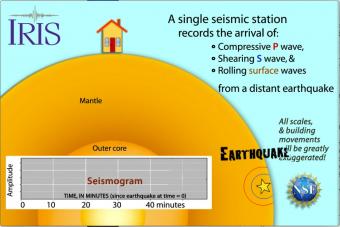
Seismic waves travel through the earth to a unmarried seismic station. Calibration and motion of the seismic station are greatly exaggerated to depict the relative motion recorded by the seismogram as P, S, and surface waves arrive.
Blitheness Novice

Nosotros apply exaggerated movement of a building (seismic station) to evidence how the ground moves during an earthquake, and why it is important to measure seismic waves using 3 components: vertical, N-S, and E-West. Earlier showing an actual distant earthquake, nosotros break down the three axes of movement to clarify the 3 seismograms.
Animation Novice
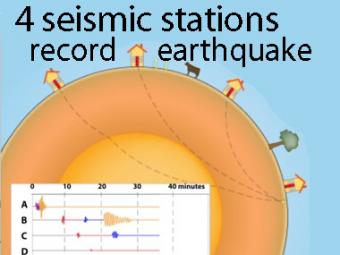
A cow and a tree in this narrated cartoon for fun and to emphasize that seismic waves traveling away from an earthquake occur everywhere, non just at seismic stations A, B, C, and D. A person would feel a large earthquake merely at station A near the epicenter. Stations B, C, D, and the cow are too far from the earthquake to feel the seismic waves though sensitive equipment records their arrival.
Animation Novice
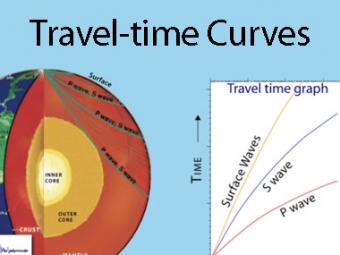
A travel fourth dimension curve is a graph of the time that it takes for seismic waves to travel from the epicenter of an convulsion to the hundreds of seismograph stations around the world. The arrival times of P, S, and surface waves are shown to be predictable. This animates an IRIS affiche linked with the blitheness.
Animation Novice

The Earth has 3 principal layers based on chemical composition: crust, mantle, and core. Other layers are defined by physical characteristics due to pressure and temperature changes. This animation tells how the layers were discovered, what the layers are, and a bit near how the crust differs from the tectonic (lithospheric) plates, a distinction confused by many.
Animation Novice
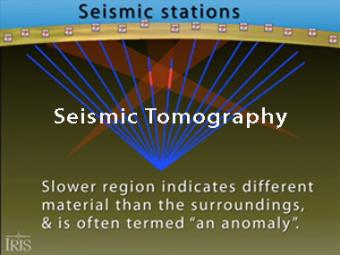
Seismic tomography is an imaging technique that uses seismic waves generated past earthquakes and explosions to create computer-generated, three-dimensional images of Earth's interior. Cat scans are often used as an analogy. Hither we simplify things and make an Earth of uniform density with a wearisome zone that nosotros paradigm as a magma bedroom.
Animation Novice

Seismic shadow zones have taught the states much nigh the inside of the earth. This shows how P waves travel through solids and liquids, only S waves are stopped by the liquid outer core.
Animation Novice

The wave properties of calorie-free are used as an analogy to help u.s. understand seismic-wave behavior.
Animation Novice

The shadow zone is the area of the globe from angular distances of 104 to 140 degrees from a given convulsion that does not receive whatsoever direct P waves. The dissimilar phases show how the initial P wave changes when encountering boundaries in the Earth.
Animation Novice
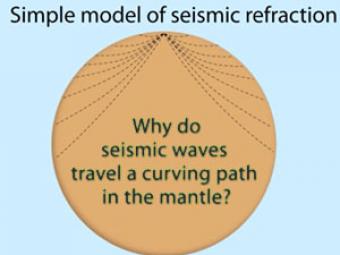
Seismic waves travel a curving path through the earth due to changes in composition, force per unit area, and temperature within the layers of the World.
Animation Novice
Related Interactives
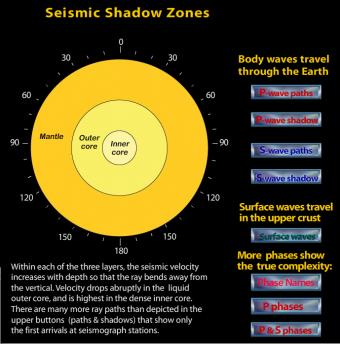
Roll over the buttons to run across the difference between P- and S-wave seismic paths also every bit their respective shadow zones.
Interactive Novice

Whorl over the buttons to see the difference between P- and S-wave seismic paths as well every bit their respective shadow zones.
Interactive Novice
Related Software-Web-Apps
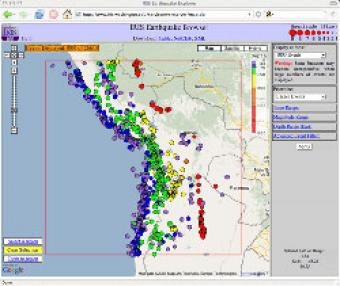
The IRIS Convulsion Browser (IEB) is an interactive tool for exploring millions of seismic event epicenters (normally earthquakes) on a map of the world. Selections of up to 5000 events tin can too be viewed in 3D and freely rotated with the 3D Viewer companion tool.
Software-Web-App Novice
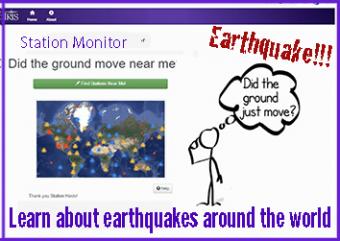
A beautiful map of the latest earthquakes in virtually-real time. The map also provides links to related resources, news, and connections to 3D maps.
Software-Spider web-App Novice
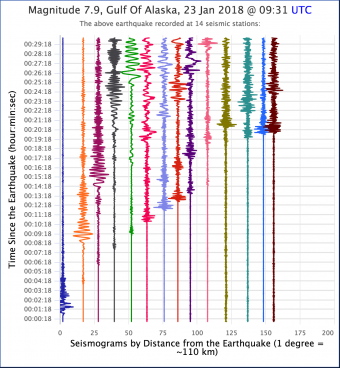
Easily view seismograms from stations around the world for large earthquakes. Plots can be used for a variety of activities including to determine the diameter of Earth's outer core as role of a classroom exercise.
Software-Web-App Novice
Related Posters
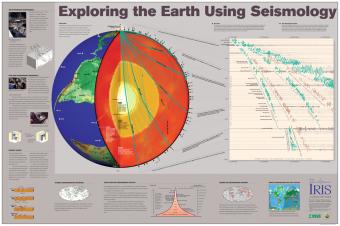
Seismic waves from earthquakes ricochet throughout Earth's interior and are recorded at geophysical observatories effectually the earth. The paths of some of those seismic waves and the ground movement that they caused are used by seismologists to illuminate Globe's deep interior.
Poster Intermediate
stewartsaidee1971.blogspot.com
Source: https://www.iris.edu/hq/inclass/lesson/imaging_earths_interior_with_seismic_waves
Post a Comment for "what techniques do we use to study the interior of the earth"